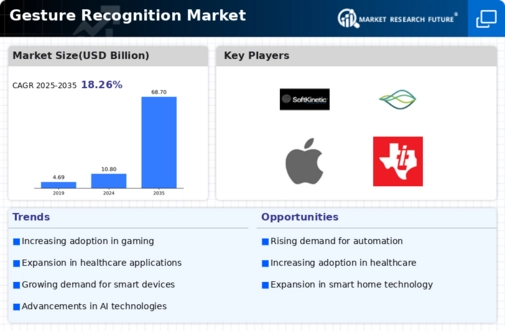Market Share
Gesture Recognition Market Share Analysis
The utilization of 3D sensing technology is on the rise, driven by its increasing applications in various domains. One notable area where 3D sensing has witnessed a surge is in gaming applications, owing to the growing popularity of virtual reality and augmented reality experiences. The introduction of 3D sensors in gaming has been particularly noteworthy, with the Xbox Kinect playing a pivotal role in bringing these sensors into the mainstream.
The contemporary gaming landscape is characterized by high-end computer systems equipped with dual-core processors, contributing to the widespread adoption of 3D sensor-based gaming. This trend is prevalent not only in PC gaming but also within the console gaming community. The surge in demand for gaming experiences, coupled with the rise of augmented reality, has emerged as a key driver for the growth of the 3D sensors market. Major players in the tech industry, such as Apple and Sony, are actively investing in the 3D sensing market to capitalize on its potential. Apple's acquisition of PrimeSense, a 3D sensing company, underscores the commitment to advancing developments in 3D sensing technology.
The gaming possibilities afforded by 3D sensing technology are directly proportional to the number of sensing elements, opening up new dimensions of gameplay. The complexity of creating innovative games is a challenge, but the rate of adoption of 3D sensing in gaming communities is substantial and continually growing. The integration of 3D sensors has transformed the gaming landscape, particularly in the realm of intuitive game design, providing users with more immersive and interactive experiences.
Another significant driver for the growth of the 3D sensors market is the increasing demand for security and surveillance solutions. In today's world, where security is a paramount concern, high-resolution cameras play a crucial role in monitoring and maintaining a secure environment. The heightened awareness of security issues has fueled the adoption of image sensors within the 3D sensor market. Biometrics, a method used for identity verification or recognition, relies on image sensors operating in the visual spectrum. These sensors are instrumental in capturing fingerprint patterns, palm prints, hand and face geometry, iris, and retina patterns. The application of image sensors in biometrics is well-suited for security check-ins and the authentication processes involved in national documents.
Furthermore, image sensors find increasing use in surveillance areas where the tracking of individuals is essential. Night vision sensors, a subset of image sensors, can be implemented in residential areas and corporate sectors for surveillance purposes, enhancing security measures. The demand for robust security solutions is propelling the integration of 3D sensing technology, contributing to the overall growth of the market.
In conclusion, the expanding applications of 3D sensing technology in gaming and security domains underscore its versatility and relevance in addressing diverse needs. The continual investments by major players in the technology affirm its potential for transformative impacts across various industries.

















Leave a Comment